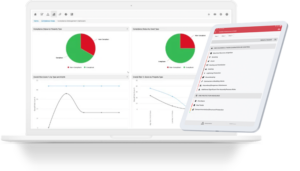20 May

A risk management plan is a written document that details foreseeable risks and responses to those risks in order to be understood and managed proactively.
Ever heard the old adage ‘When you fail to plan, you plan to fail’?. We can all recognise that it’s easy to plan for the positive outcomes but a little bit harder to prepare for the negative ones. It’s natural to want and believe that all of our projects will run smoothly; however, not considering and planning potential risks could be dangerous. So don’t go sticking your head in the sand; the Ostrich strategy is not part of the plan!!!
What is a Risk Management Plan?
A risk management plan is a document that clearly identifies potential risks and estimates the impact and probability of them happening. It also outlines how to deal with specific risks and what management actions must be taken against them to minimise or remove threats.
Risks are uncertainties in scope, schedule, cost or quality. Creating a risk management plan identifies those uncertainties and establishes a system to maximise the positive effects while mitigating the potential negatives.
The risk management plan gives you an idea of actions you need to identify, analyse, and respond to all the risks within a project wheel.
This plan is part of a risk management process that exists during the whole life cycle. The risk management process brings together all of the forces that cause the project management team to treat risks.
4 Steps to Follow When Developing a Risk Management Plan
Risks are waiting around every dark corner. With every new piece of work, unknown risks are waiting. Although we cannot avoid every risk, we can mitigate and anticipate them through a robust risk management plan.
By following these steps, you can have a successful risk management plan and make your team more alert and agile when managing adverse outcomes.
Step 1. Identification
Foreseeing possible adverse outcomes of a project does not have to be the end for an organisation. In fact, identifying risks can be a positive experience that you can learn from, and the team can take part in.
Why not leverage the collective experience and knowledge of your entire team in risk management. Ask them to help identify risks they may already have insight into it or experienced before.
Step 2. Analysing the risk
So, now you have identified the potential risks, you need to delve a little deeper.
How often do the risks occur?
If they occur, what might the consequences be?
Here you evaluate the outcome and likelihood of each risk and where to place your focus first. When analysing the risks, you should include potential harm caused, time lost, financial loss to the organisation and the severity of impact.
By processing the minutia of each risk, you’ll also expose any re-occurring issues across a project and help refine the risk management plan for future projects.
Step 3. Prioritisation of the risk
After analysing the risks, it’s time to prioritise. You do this by ranking each risk by considering the probability of it happening and its possible effect.
This step provides you with a birds-eye view of the project at hand and helps to point out where the team’s focus should be. In addition, it helps to identify any workable solutions for each prioritised risk.
Step 4. Mitigating the risk
Once the risk is identified, execute your treatment plan. Start with the highest priority risk and look to either mitigate or at least solve it so that it’s no longer a threat.
As you generate a more extensive database of your previous projects along with risk logs, you will be better equipped to predict potential risks proactively rather than reactively for better treatment.
Step 5. Monitoring the risk
As the project or piece of work moves forward, the risk management plan takes care of all the risks that you may encounter on the way. Since all the risk management plan outcomes are documented, keeping tabs on those moving targets becomes essential! Therefore, reviewing this document at regular intervals of time is crucial.
Is it possible to save time without compromising on quality? Find out more.
Benefits of Writing a Risk Management Plan
Risk management plans have numerous benefits that make it a worthwhile effort for every organisation. From helping identify the potential risks faced to mitigating and potentially solving them. Being aware of these risks allows a company to make the necessary plans and manage them when they arise. Aside from the obvious, a risk management plan:
- Can help boost results
Creating a risk management plan for your organisation raises your chances of a successful project as it mitigates and removes harmful risks.
This will help your project run smoothly, enables you to meet the budget and smash targeted goals. However, without a defined risk management strategy in place, your project is more likely to be vulnerable and exposed to problems. - Foster proactive behaviours, so not having to rely on reactive behaviours
Having a risk management plan will foster proactivity; it enables you to take the steps required to reduce potential issues before they happen, instead of being a step behind reacting to each problem after it has occurred. In addition, it enables your business/team to take the risk recognised and shift to workable measures that will reduce the likelihood of the negative outcome occurring. - Helps you to evaluate the Entire Project
With the help of a risk management plan, you can assess the impact of your tasks by diminishing exposure to risk and take full advantage of opportunities that capitalise on your organisations’ strengths. In addition, it can help you evaluate your current project’s success and build best practices for the future in simpler terms.
How Risk Warden Assists with Risk Management and Management Planning
Here are some key areas where Risk Warden can help you with Risk Management and management planning. With Risk Warden, you can:
- Reduce your risk assessment score every time a task is completed, providing instant results.
- Invite colleagues and contractors, creating, planning and actioning your risk management journey.
- Assign tasks directly to contractors
- Create, customise and share your own reports and dashboards.
- Store PDFs, videos, images, charts, and more in the document repository for easy access.
- Plot hazards directly onto a floorplan or in list mode.
- Utilise preset evaluation criteria, recommendations and actions, all of which can be customised to suit your business.
- Improve your team’s consistency and save time with Templates that use weights.
- Standardise how you assess different environments and what information needs to be gathered.
- Help you by keeping all your risk-related documents in one place, making them available to the right people across your organisation.
- Automatically remind you about those documents that require periodic renewals or inspections. This will save you time and help your organisation remain compliant.
- Link a single document to multiple assessable areas/units within your organisation, saving you loads of time.
- Automatic document version control, so the option to view the most up to date document or roll back to a previous version is at your fingertips.
- Convert your risk assessments into actionable tasks which can be re-assigned or delegated and completed in seconds using bulk or single-mode.
Risks happen and manage to find their way into every place of work or project. With a clearly defined and robust risk management plan, it will be easier to find your way through the process, which means that you can lessen the impact of risk more effectively.
Find out more about the risk management process here.
The risk management plan is a living, breathing document that requires constant monitoring and improvement as a situation demands.
Move to digital, Risk Warden can help you assess and manage your risk without the complicated, lengthy process; let us do the work!
Start creating your risk management plan documents today and sign up for a free Risk Warden account to experience just how easy it can be for yourself.


